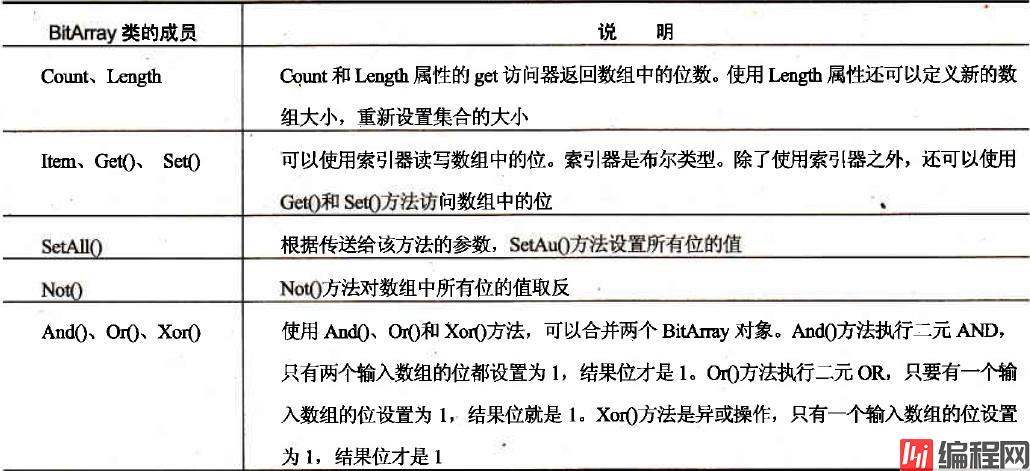如果需要处理的数字有许多位,就可以使用BitArray类和BitVector32结构。BitArray类位于System.Collection,BitVector32结构位于Syst
如果需要处理的数字有许多位,就可以使用BitArray类和BitVector32结构。BitArray类位于System.Collection,BitVector32结构位于System.Collection.Specialized。
这两种类型最重要的区别是,BitArray类可以重新设置大小,如果事先不知道需要的位数,就可以使用BitArray类。BitVector32结构是基于栈的,因此比较快。BitVector32结构仅包含32位,它们存储在一个整数中。
BitArray类是一个引用类型,它包含一个int数组,其中每32位使用一个新整数。

示例:
static void BitArrayDemo()
{
var bits1 = new BitArray(8);
bits1.SetAll(true);
bits1.Set(1, false);
bits1[5] = false;
bits1[7] = false;
Console.Write("initialized: ");
DisplayBits(bits1);
Console.WriteLine();
//int i = Convert.ToInt32(bits1);
DisplayBits(bits1);
bits1.Not();
Console.Write(" not ");
DisplayBits(bits1);
Console.WriteLine();
var bits2 = new BitArray(bits1);
bits2[0] = true;
bits2[1] = false;
bits2[4] = true;
DisplayBits(bits1);
Console.Write(" or ");
DisplayBits(bits2);
Console.Write(" : ");
bits1.Or(bits2);
DisplayBits(bits1);
Console.WriteLine();
DisplayBits(bits2);
Console.Write(" and ");
DisplayBits(bits1);
Console.Write(" : ");
bits2.And(bits1);
DisplayBits(bits2);
Console.WriteLine();
DisplayBits(bits1);
Console.Write(" xor ");
DisplayBits(bits2);
bits1.Xor(bits2);
Console.Write(" : ");
DisplayBits(bits1);
Console.WriteLine();
}
static void DisplayBits(BitArray bits)
{
foreach (bool bit in bits)
{
Console.Write(bit ? 1 : 0);
}
}如果事先知道需要的位数,就可以使用BitVector32结构代替BitArry类。BitVector32结构效率较高,因为它是一个值类型,在整数栈上存储位。一个整数可以存储32位。如果需要更多的位,可以使用多个BitVector32值或BitArray类。

//对CreateMask方法的第一个调用来访问第一位的一个掩码
//调用CreateMask后,bit1被设置为1。再次调用CreateMask方法,把第一个掩码作为参数传递给CreateMask方法,返回来第二位的一个掩码(是2)
var bits1 = new BitVector32();
int bit1 = BitVector32.CreateMask(); //1
int bit2 = BitVector32.CreateMask(bit1); //2
int bit3 = BitVector32.CreateMask(bit2); //4
int bit4 = BitVector32.CreateMask(bit3); //8
int bit5 = BitVector32.CreateMask(bit4); //16
bits1[bit1] = true;
bits1[bit2] = false;
bits1[bit3] = true;
bits1[bit4] = true;
Console.WriteLine(bits1);输出:

//除了用CreateMask方法创建掩码之外,还可以自己定义掩码,也可以一次设置多位。
//十六进制abcdef与二进制1010 1011 1100 1101 1110 1111相同
bits1[0xabcdef] = true;
Console.WriteLine(bits1);输出:

//也可以把32位分别放在不同的片段中
bits1[0xabcdef] = true;
Console.WriteLine(bits1);
int received = 0x79abcdef;
var bits2 = new BitVector32(received);
Console.WriteLine(bits2);
//创建6个片段。第一个片段需要12位,有16进制0xfff定义。
//第一次调用CreateSection方法直接受0xfff,为最前面的12位分配内存。
//第二次调用CreateSection方法,将第一个片段和偏移量传递
BitVector32.Section sectionA = BitVector32.CreateSection(0xfff);
BitVector32.Section sectionB = BitVector32.CreateSection(0xff, sectionA);
BitVector32.Section sectionC = BitVector32.CreateSection(0xf, sectionB);
BitVector32.Section sectionD = BitVector32.CreateSection(0x7, sectionC);
BitVector32.Section sectionE = BitVector32.CreateSection(0x7, sectionD);
BitVector32.Section sectionF = BitVector32.CreateSection(0x3, sectionE);
//bits2[sectionA],把一个BitVector32.Section类型的值传递给BitVector32结构的索引器,会返回一个int。IntToBinaryString方法将这个int表示
Console.WriteLine("Section A: " + IntToBinaryString(bits2[sectionA], true));
Console.WriteLine("Section B: " + IntToBinaryString(bits2[sectionB], true));
Console.WriteLine("Section C: " + IntToBinaryString(bits2[sectionC], true));
Console.WriteLine("Section D: " + IntToBinaryString(bits2[sectionD], true));
Console.WriteLine("Section E: " + IntToBinaryString(bits2[sectionE], true));
Console.WriteLine("Section F: " + IntToBinaryString(bits2[sectionF], true));
static string IntToBinaryString(int bits, bool removeTrailingZero)
{
var sb = new StringBuilder(32);
for (int i = 0; i < 32; i++)
{
if ((bits & 0x80000000) != 0)
{
sb.Append("1");
}
else
{
sb.Append("0");
}
bits = bits << 1;
}
string s = sb.ToString();
if (removeTrailingZero)
return s.TrimStart('0');
else
return s;
}输出:

--结束END--
本文标题: C#集合之位数组的用法
本文链接: https://lsjlt.com/news/145692.html(转载时请注明来源链接)
有问题或投稿请发送至: 邮箱/279061341@qq.com QQ/279061341
2024-03-01
2024-03-01
2024-02-29
2024-02-29
2024-02-29
2024-02-29
2024-02-29
2024-02-29
2024-02-29
2024-02-29
回答
回答
回答
回答
回答
回答
回答
回答
回答
回答
0